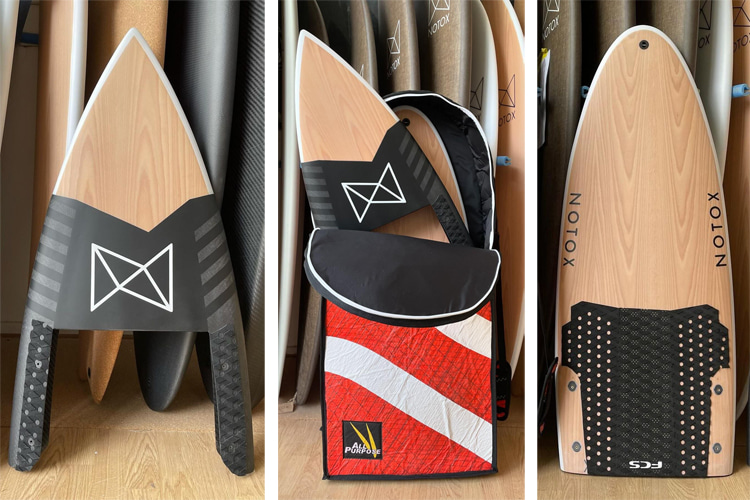French surfboard building company Notox developed a modular shortboard to make surf trips on the bus and train easier.
Collapsible surfboards are not new.
In 1964, Karl Pope and Thomas Price pioneered this innovative concept by registering the patent for a surfboard that could be collapsed and disassembled for "compact storage and ease in handling without losing any desirable feature of the non-collapsible type of board."
The first commercially available model was released in 1965.
The Morey-Pope Trisect was a joint venture between Pope and Tom Morey, who would later invent the bodyboard.
Since then, there have been many attempts to market foldable or split surfboards that can dodge bus, train, bike, and even airplane limitations.
Most of them met a lack of interest or a very small number of potential interested customers.
Why?
Mostly because the idea of splitting a surfboard into parts like Lego basically "breaks" the convention of what a high-performance shortboard is, i.e., a one-piece design that can cut and glide across the water with minimal drag and inertia.
Notox is a small surfboard company with a strong emphasis on minimizing the traditional environmental impacts of surfboard shaping.
The creation of a collapsible surfboard is an attempt to meet some of their customer surfers' updated lifestyles.
"Slow tourism is an obvious choice for those who want to reduce the environmental impact of their travels: take the time and discover the hidden gems closer to home, without having to take a plane to go to the other side of the planet," the Basque country brand explains.
"The train is, therefore, one of the preferred means of transport for slow tourism."
"But very often, the constraints in terms of luggage size do not allow you to travel easily with surfboards."
Lighter, Thanks to Airbus A380 Waste
Notox knew they weren't reinventing the wheel. But they wanted to solve one of the major problems of existing collapsible systems: weight.
And so they got to work to allow customers to order custom-made, collapsible models and let them choose design details like the cutting position, decoration, assembly system, etc.
"Our system allows us to make any custom board model collapsible, with an extra weight of only 500 to 700 grams depending on the model," the company adds.
"This means that this extra weight has much less impact on the performance of the boards."
"The boards can be offered in two parts or three parts, in the case of Malibus and longboards."
According to Notox, the development phase required several months of learning, work, and experimentation.
The assembly rails are made from scraps of very rigid aeronautical carbon fabric taken from Airbus A380 production waste.
These rails are vacuum-formed so that they fit exactly to the surface of the board, as there is no mechanical interaction.
Thus, the parts of the boards fit together perfectly and are locked using stainless steel quick screws.
To make traveling easier and more practical, Notox invited sailmaking workshop All Purpose to create special bags made from upcycled boat sails.
The prototype models have already been successfully travel-tested on a train trip across the Iberian Peninsula.
Notox is open to collaborations that might help develop and distribute their collapsible surfboard model at scale.
Words by Luís MP | Founder of SurferToday.com


